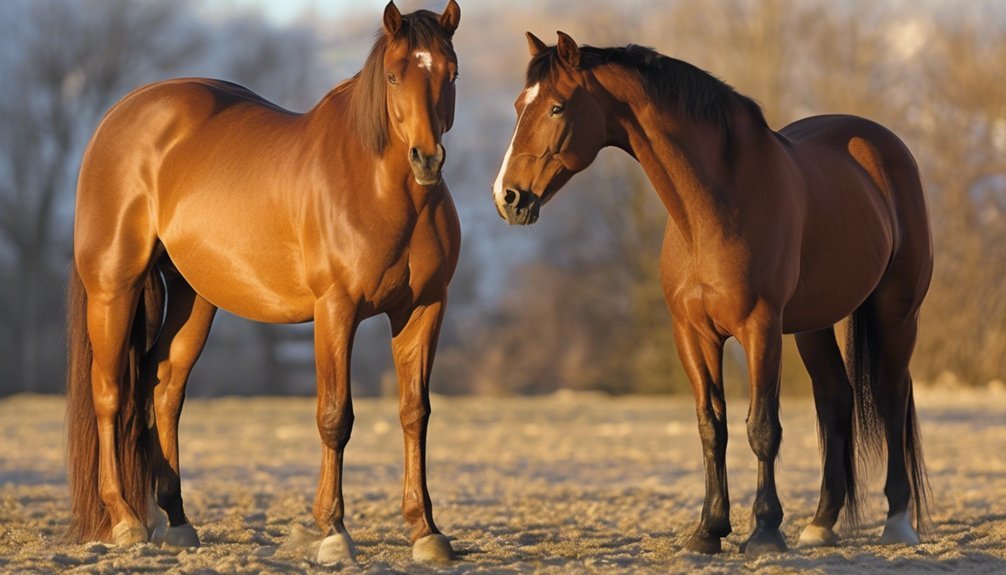
Many might think a horse's coat is purely aesthetic, but it actually reflects overall health and well-being. A glossy, vibrant coat signals proper nutrition and care, while a dull, rough appearance can indicate underlying issues. Understanding these signs is crucial for maintaining your horse's health. Explore the various characteristics of a healthy coat and learn how nutrition, grooming, and potential health concerns play vital roles in its appearance.
Key Takeaways
- A healthy coat is glossy and vibrant, indicating good hydration and grooming practices.
- An unhealthy coat appears dull and rough, suggesting potential health issues or inadequate care.
- Excessive shedding in an unhealthy coat may indicate stress, parasites, or poor nutrition.
- A vibrant coat has a soft texture, while a rough coat indicates insufficient grooming or nutritional deficiencies.
- Regular grooming and a balanced diet are essential for maintaining a healthy coat and preventing skin conditions.
The Importance of a Healthy Coat

A healthy coat is essential not only for your horse's appearance but also for its overall well-being. Proper coat maintenance reflects your horse's health, indicating good nutrition and care.
Regular grooming plays a crucial role in maintaining coat quality, helping to remove dirt, debris, and dead hair. Seasonal grooming is particularly important; during shedding seasons, you'll need to adjust your routine to accommodate the increased hair loss.
This not only keeps your horse comfortable but also promotes circulation and skin health. By prioritizing coat maintenance and seasonal grooming, you're fostering a bond with your horse while ensuring it remains healthy and happy.
Characteristics of a Vibrant Coat
Grooming and nutrition contribute significantly to the characteristics of a vibrant coat.
A horse with a healthy coat showcases several key features that indicate well-being:
- Coat Shine: A glossy surface reflects light, indicating good hydration and proper grooming.
- Color Vibrancy: Rich, deep colors demonstrate a balanced diet and effective care.
- Smooth Texture: A soft and supple feel suggests appropriate grooming routines and skin health.
- Minimal Dullness: Lack of any patchiness or dryness signals effective nutrition and care practices.
Signs of a Dull or Lifeless Coat

Observing a horse with a dull or lifeless coat can be concerning, as it often signals underlying health issues or inadequate care. Common dull coat causes include poor nutrition, stress, and parasitic infections. You might notice a lack of shine, rough texture, or excessive shedding, all indicators that something's off.
To address a lifeless coat, consider implementing remedies such as improving your horse's diet with high-quality feed and supplements rich in omega fatty acids. Regular grooming can also stimulate the skin and promote blood circulation, enhancing coat vitality.
Additionally, ensuring a low-stress environment and addressing any health concerns with your veterinarian can significantly improve your horse's coat appearance, restoring that vibrant shine you desire.
The Role of Nutrition in Coat Health
Since nutrition plays a crucial role in your horse's overall health, it directly impacts the condition of their coat. A well-balanced diet ensures your horse receives essential nutrients for a shiny, healthy coat.
Consider these key factors in your horse's nutrition:
- Protein: Vital for hair growth and structure.
- Fatty Acids: Omega-3 and Omega-6 promote shine and moisture.
- Vitamins: A and E support skin health and coat condition.
- Minerals: Zinc and copper contribute to pigmentation and strength.
If you notice coat issues, dietary adjustments or nutritional supplements may be necessary.
Consult with your veterinarian to create a tailored plan that addresses your horse's specific needs. A proper diet can make all the difference in achieving a vibrant coat.
Common Skin Conditions Affecting Coats

Even with proper nutrition, horses can still experience a variety of skin conditions that affect the health and appearance of their coats.
Skin infections, often caused by bacteria or parasites, can lead to irritation, hair loss, and unsightly blemishes. You might notice your horse scratching or showing signs of discomfort.
Fungal issues, such as ringworm or dermatitis, can also disrupt coat quality, resulting in flaky, scaly patches. These conditions can stem from poor hygiene or damp environments.
It's crucial to monitor your horse's skin regularly, looking for changes in texture or color. Early detection and treatment can prevent more severe complications, ensuring your horse's coat remains vibrant and healthy.
Always consult your veterinarian for appropriate diagnosis and treatment options.
The Impact of Seasonal Changes on Coat Condition
As the seasons change, so do the demands on your horse's coat, impacting its overall health and appearance.
You'll notice your horse engaging in seasonal shedding, which can affect coat thickness. Understanding these changes is crucial for maintaining a healthy coat.
Here are four key factors to consider:
- Temperature Fluctuations: Horses grow thicker coats for winter insulation.
- Humidity Levels: Increased humidity can lead to coat dullness and skin issues.
- Sun Exposure: Prolonged sunlight can fade coat color and damage hair follicles.
- Dietary Changes: Nutritional needs may shift with seasonal changes, impacting coat quality.
Identifying Lumps and Bumps

When you inspect your horse, being vigilant for lumps and bumps is essential for assessing overall health.
Start with lump identification, feeling along your horse's body for any unusual protrusions. Pay attention to the size, shape, and texture of these lumps, as they can indicate different health issues.
For bump assessment, examine areas like the girth and legs, where soft tissue swellings may develop. Note any changes in temperature or sensitivity, as these can signal underlying problems.
If you discover persistent or painful lumps or bumps, consult your veterinarian promptly. Regular monitoring helps ensure your horse remains healthy and can prevent serious conditions from escalating.
Your attention to these details fosters a strong bond and promotes your horse's well-being.
The Effect of Parasites on Coat Health
Parasites can significantly impact your horse's coat health, often leading to noticeable changes in appearance and texture.
Regular coat inspection is essential for identifying the signs of infestations. When parasites are present, you might observe:
- Dullness or lack of shine
- Patchy hair loss or excessive shedding
- Skin irritation or inflammation
- Increased itching or discomfort
These symptoms indicate that effective parasite prevention is crucial for maintaining a healthy coat.
Regular deworming and proper management practices can help keep your horse free from these harmful invaders.
Grooming Tips for Maintaining a Healthy Coat

A consistent grooming routine is essential for maintaining a healthy coat on your horse. Start by selecting quality grooming products, such as curry combs and soft-bristled brushes, to effectively remove dirt and debris. Use circular motions with the curry comb to loosen dirt before brushing. For sensitive areas, opt for gentler brushes.
Incorporate a regular schedule, grooming your horse at least a few times a week, to promote circulation and distribute natural oils evenly. Pay attention to your horse's coat condition; shiny coats indicate good health.
Additionally, consider using coat supplements if necessary, but always consult with a knowledgeable source. By combining proper brushing techniques with the right products, you'll keep your horse's coat looking vibrant and healthy.
When to Consult a Veterinarian
Recognizing changes in your horse's coat can be crucial for detecting underlying health issues, so it's important to stay vigilant.
If you notice any of the following signs, it's time for a vet check:
- Significant hair loss or bald patches.
- Unusual coat texture, such as brittleness or excessive oiliness.
- Change in coat color, especially if accompanied by other symptoms.
- Persistent skin lesions or irritations.
A thorough coat evaluation by a veterinarian can help identify potential problems early.
Don't hesitate to consult a professional if your horse's coat shows concerning changes.
Early intervention can make a difference in your horse's overall health, ensuring they stay happy and vibrant.
Frequently Asked Questions
How Often Should I Groom My Horse for Optimal Coat Health?
To maintain optimal coat health, groom your horse at least three to four times a week, increasing frequency during seasonal shedding. This helps remove dirt, debris, and loose hair, promoting a healthy, shiny coat.
Can Stress Affect My Horse's Coat Condition?
Yes, stress can significantly impact your horse's coat condition. You might notice stress indicators like dullness or unevenness in coat changes, reflecting your horse's overall well-being and emotional state. Regular monitoring helps maintain a healthy coat.
What Are the Best Supplements for Improving Coat Shine?
To achieve a coat that shines like the sun, consider high-quality coat supplements rich in omega fatty acids and shine enhancers like biotin. These nutrients promote luster and overall health, giving your horse's coat a dazzling appearance.
How Do I Choose the Right Grooming Tools for My Horse?
When you choose grooming tools, consider the tool materials and how they complement your grooming techniques. Opt for brushes that suit your horse's coat type, ensuring comfort and effectiveness during your grooming sessions for optimal results.
Are There Specific Breeds Prone to Coat Issues?
Yes, certain breeds can be more prone to coat issues due to breed characteristics. For instance, horses with specific coat colors may exhibit unique sensitivities or conditions, affecting their overall coat health and appearance.
Conclusion
In conclusion, a horse's coat is a mirror reflecting its overall health. Picture a glossy, shimmering coat that catches the sunlight, signifying proper care and nutrition. Conversely, envision a dull, rough coat that lacks vibrancy, hinting at underlying issues. By prioritizing balanced nutrition, regular grooming, and vigilance for any signs of distress, you can help ensure your horse's coat remains a testament to its vitality and well-being. Don't hesitate to seek veterinary advice when needed.





